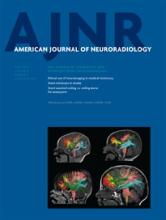Index by author
Pogribna, U.
- Pediatric NeuroimagingOpen AccessRole of Diffusion Tensor Imaging as an Independent Predictor of Cognitive and Language Development in Extremely Low-Birth-Weight InfantsU. Pogribna, K. Burson, R.E. Lasky, P.A. Narayana, P.W. Evans and N.A. ParikhAmerican Journal of Neuroradiology April 2014, 35 (4) 790-796; DOI: https://doi.org/10.3174/ajnr.A3725
Pope, W.B.
- BrainOpen AccessPretreatment ADC Histogram Analysis Is a Predictive Imaging Biomarker for Bevacizumab Treatment but Not Chemotherapy in Recurrent GlioblastomaB.M. Ellingson, S. Sahebjam, H.J. Kim, W.B. Pope, R.J. Harris, D.C. Woodworth, A. Lai, P.L. Nghiemphu, W.P. Mason and T.F. CloughesyAmerican Journal of Neuroradiology April 2014, 35 (4) 673-679; DOI: https://doi.org/10.3174/ajnr.A3748
Prestigiacomo, C.
- FELLOWS' JOURNAL CLUBNeurointerventionOpen AccessStent-Assisted Coiling versus Coiling Alone in Unruptured Intracranial Aneurysms in the Matrix and Platinum Science Trial: Safety, Efficacy, and Mid-Term OutcomesS.W. Hetts, A. Turk, J.D. English, C.F. Dowd, J. Mocco, C. Prestigiacomo, G. Nesbit, S.G. Ge, J.N. Jin, K. Carroll, Y. Murayama, A. Gholkar, S. Barnwell, D. Lopes, S.C. Johnston and C. McDougall on behalf of the Matrix and Platinum Science Trial InvestigatorsAmerican Journal of Neuroradiology April 2014, 35 (4) 698-705; DOI: https://doi.org/10.3174/ajnr.A3755
These authors analyzed data on 131 non-selected MCA aneurysms treated during a 6-year period. One month after treatment, permanent morbidity and mortality was 3.3% without significant differences according to technique used. The rate of recanalization was nearly 16%, also without differences according to technique, and re-treatment was needed in 7.6% of cases. A greater rate of complications occurred with balloon remodeling and only large aneurysm size predicted recanalization. The authors concluded that endovascular treatment of MCA aneurysms is safe, effective, and durable.
Qazi, A.
- FELLOWS' JOURNAL CLUBBrainOpen AccessDWI Reversal Is Associated with Small Infarct Volume in Patients with TIA and Minor StrokeN. Asdaghi, B.C.V. Campbell, K.S. Butcher, J.I. Coulter, J. Modi, A. Qazi, M. Goyal, A.M. Demchuk and S.B. CouttsAmerican Journal of Neuroradiology April 2014, 35 (4) 660-666; DOI: https://doi.org/10.3174/ajnr.A3733
The implications of the reversal of DWI abnormalities in patients with TIA and minor strokes were assessed. Patients were imaged within 24 hours of symptoms and followed for 3 months and baseline and final infarct volumes were calculated using DWI and FLAIR, respectively. Over 55% of patients had DWI lesions and 37% had perfusion deficits. DWI reversal occurred in 6% of patients with lesion volume being considerably smaller than in those that did not reverse. Perfusion abnormalities were less common in reversible lesions as well. The authors concluded that DWI lesion reversal is uncommon and more likely with smaller lesions.
Raz, E.
- Extracranial VascularYou have accessCorrelation between Fissured Fibrous Cap and Contrast Enhancement: Preliminary Results with the Use of CTA and Histologic ValidationL. Saba, E. Tamponi, E. Raz, L. Lai, R. Montisci, M. Piga and G. FaaAmerican Journal of Neuroradiology April 2014, 35 (4) 754-759; DOI: https://doi.org/10.3174/ajnr.A3759
- NeurointerventionYou have accessVariable Porosity of the Pipeline Embolization Device in Straight and Curved Vessels: A Guide for Optimal Deployment StrategyM. Shapiro, E. Raz, T. Becske and P.K. NelsonAmerican Journal of Neuroradiology April 2014, 35 (4) 727-733; DOI: https://doi.org/10.3174/ajnr.A3742
Renowden, S.A.
- FELLOWS' JOURNAL CLUBNeurointerventionYou have accessEndovascular Treatment of 300 Consecutive Middle Cerebral Artery Aneurysms: Clinical and Radiologic OutcomesA.M. Mortimer, M.D. Bradley, P. Mews, A.J. Molyneux and S.A. RenowdenAmerican Journal of Neuroradiology April 2014, 35 (4) 706-714; DOI: https://doi.org/10.3174/ajnr.A3776
Controversy about the best treatment method for MCA aneurysms persists and these authors report the results of endovascular treatment of these lesions in a large series in which 295 such aneurysms were treated during a 17-year period and the results retrospectively analyzed. Complete occlusion was achieved in 94% and treatment failed in 4.3%. Procedure-related morbidity and mortality occurred in nearly 8%. Death occurred in 13.6% of patients and 4.3% needed to be re-treated. Thus, endovascular treatment of MCA aneurysms is acceptable as a primary treatment.
Ringleb, P.A.
- NeurointerventionYou have accessEmergency Cervical Internal Carotid Artery Stenting in Combination with Intracranial Thrombectomy in Acute StrokeS. Stampfl, P.A. Ringleb, M. Möhlenbruch, C. Hametner, C. Herweh, M. Pham, J. Bösel, S. Haehnel, M. Bendszus and S. RohdeAmerican Journal of Neuroradiology April 2014, 35 (4) 741-746; DOI: https://doi.org/10.3174/ajnr.A3763
Riquelme, C.
- NeurointerventionYou have accessStent Retrievers in Acute Ischemic Stroke: Complications and Failures during the Perioperative PeriodG. Gascou, K. Lobotesis, P. Machi, I. Maldonado, J.F. Vendrell, C. Riquelme, O. Eker, G. Mercier, I. Mourand, C. Arquizan, A. Bonafé and V. CostalatAmerican Journal of Neuroradiology April 2014, 35 (4) 734-740; DOI: https://doi.org/10.3174/ajnr.A3746
Riva, R.
- NeurointerventionYou have accessEndovascular Treatment of Middle Cerebral Artery Aneurysms for 120 Nonselected Patients: A Prospective Cohort StudyB. Gory, A. Rouchaud, S. Saleme, F. Dalmay, R. Riva, F. Caire and C. MounayerAmerican Journal of Neuroradiology April 2014, 35 (4) 715-720; DOI: https://doi.org/10.3174/ajnr.A3781
Rohde, S.
- NeurointerventionYou have accessEmergency Cervical Internal Carotid Artery Stenting in Combination with Intracranial Thrombectomy in Acute StrokeS. Stampfl, P.A. Ringleb, M. Möhlenbruch, C. Hametner, C. Herweh, M. Pham, J. Bösel, S. Haehnel, M. Bendszus and S. RohdeAmerican Journal of Neuroradiology April 2014, 35 (4) 741-746; DOI: https://doi.org/10.3174/ajnr.A3763








